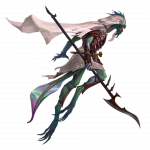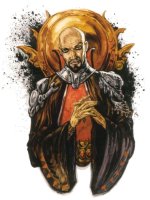Obly99
Hero
A simple conversion from PF2 with some custom abilities (Xulgath Thoughtmaw - Monsters - Archives of Nethys: Pathfinder 2nd Edition Database).
Xulgath thoughtmaws are inheritors of the xulgaths' ancient psychic legacy. They eagerly and liberally use their ability to extract knowledge from their foes to quicken their own prodigious intellects. Few thoughtmaws travel beyond the deepest vaults of the Darklands. There, they dwell in crumbling ziggurats and plumb ruins for lost knowledge, directing xulgath clutches through mental finesse or outright domination. Some seek to transcend mortal existence, while others plan conquests of the surface world.
CE Medium humanoid (reptilian)
Init +9; Senses arcane sight, darkvision 120 ft., read magic, see invisibility, thoughtsense; Perception +30
Aura psychogenic secretions (DC 26, 100 ft.)
DEFENSE
AC 30, touch 23, flat-footed 25 (+4 armor, +8 deflection, +5 Dex, +3 natural)
hp 207 (18d8+126)
Fort +13, Ref +11, Will +24; +4 vs. psychic spells
Defensive Abilities mental shield, psychic resilience; DR 10/magic; SR 27
OFFENSE
Speed 30 ft.; air walk
Melee +3 glaive +19/+14/+9/+4 (1d10+7/x3), bite +11 (1d6+1), or bite +16 (1d6+3), 2 claws +16 (1d4+3)
Special Attacks consume knowledge (DC 27)
Spell-Like Abilities (CL 18th; concentration +26)
Constant—air walk, arcane sight, read magic, see invisibility, speak with animals (dinosaurs and reptiles only), thoughtsense
At-will—analyze aura, cause fear (DC 19), charge object, charm monster (DC 22), detect mindscape (DC 21), hypnotism (DC 19), implant false reading, instigate psychic duel (DC 20), mind probe (DC 22), node of blasting (DC 21), object reading, oneiric horror (DC 21), synaptic pulse (DC 21), synaptic scramble (DC 22), telekinetic maneuver
3/day—ectoplasmic eruption (DC 25), ego whip II (DC 22), greater synaptic pulse (DC 23), mindscape door (DC 22), repress memory, synapse overload (DC 23)
1/day—catatonia, create greater mindscape, divide mind, dominate monster (DC 27) ethereal envelope, ethereal envelopment (DC 25), mindwipe (DC 22), primal regression (DC 24), psychic asylum, psychic crush V (DC 27), remote viewing, retrocognition, unshakable zeal
Psychic Magic (CL 18th, concentration +26)
24 PE—ego whip IV (4 PE, DC 22), id insinuation III (3 PE, DC 21), intellectual fortress III (2 PE), mass synesthesia (5 PE, DC 23), mental barrier V (4 PE), mind thrust VI (5 PE, DC 23), mindlink (1 PE, DC 19), psychic surgery (3 PE), silent image (1 PE, DC 19), suggestion (2 PE, DC 20), thought shield V (4 PE), tower of iron will V (5 PE)
STATISTICS
Str 16, Dex 20, Con 24, Int 26, Wis 20, Cha 22
Base Atk +13; CMB +16; CMD 39
Feats Alertness, Combat Casting, Combat Reflexes, Craft Wondrous Item, Greater Spell Penetration, Improved Initiative, Persuasive, Psychic SensitivityB, Scribe Scroll, Spell Penetration
Skills Acrobatics +8, Bluff +28, Diplomacy +28, Disable Device +23, Intimidate +27, Knowledge (arcane, history, local, planes) +29, Perception +30, Sense Motive +27, Spellcraft +29, Stealth +26 (+34 in rocky areas), Survival +23, Use Magic Device +27 (+35 for use a scroll); Racial Modifiers +8 when using an occult skill, +8 Stealth in rocky areas, +8 Use Magic Device for use a scroll
Languages Draconic, Undercommon; speak with animals (dinosaurs and reptiles only), telepathy 100 ft.
SQ intellectual mind, mental potency, occult master
Gears +3 glaive, +2 leather armor
Environment Any underground
Organization solitary or expedition (1 xulgath thoughtmaw, 1d3 xulgath ranger 3/rogue 1, 2d4 xulgath, 4d4 troglodytes ranger 1/rogue 1, 6d6 troglodytes)
Treasure double standard
Consume Knowledge (Su)
As a standard action, a xulgath thoughtmaw can try to invade the mind of a sentient creature within its psychogenic secretions area and attempts to swallow his capacity for higher thought. The creature must attempt a Will save DC 27. Success means that the creature is sickened for 1 round. If the creature fail his save, he become staggered for 1 round and for 1 minute is unable to use Intelligence– or Charisma-based skills or cast spells and spell-like abilities. The subject remains in this state until 1 minute has passed, the xulgath thoughtmaw use consume knowledge on another creature or a heal, limited wish, miracle, or wish spell is used to cancel the effect of Consume Knowledge. A xulgath thoughtmaw gains the benefit of a haste spell as long a creature is under the effect of this ability. Using Consume Knowledge immediately ends any of the ability's previous effects on a different creature. This is a compulsion, mind-affecting effect. The save DC is Intelligence-based.
Intellectual Mind (Ex)
A xulgath thoughtmaw gains 6 + Int skill ranks per racial HD and gains all Knowledge, Spellcraft, and Use Magic Device as class skills,
Mental Shield (Su)
The psychic potency of a xulgath thoughtmaw give it a deflection bonus to AC and as a racial bonus to Will save equal to its Intelligence modifier.
Mental Potency (Su)
A xulgath thoughtmaw’s intrinsic understanding of occult magic allows it to modify the concentration checks and save DCs of its racial spell-like abilities that are normally affected by Charisma to be modified instead by the xulgath’s Intelligence modifier. This doesn’t affect actual spellcasting ability, such as that granted by sorcerer levels.
Occult Master (Su)
A xulgath thoughtmaw’s intrinsic understanding of occult magic grants it Psychic Sensitivity as a bonus feat. A xulgath thoughtmaw can use occult skills even if it’s not trained in that skill. Also, when attempting a use of occult skill (like automatic writing or psychometry) or effect that replicate an occult skill (like its spell-like ability object reading), the xulgath thoughtmaw count as having rank in that skill equal to its racial HD (like for a +34 bonus for psychometry or +44 if using the spell-like ability object reading).
Psychogenic Secretions (Su)
A xulgath thoughtmaw’s stench is far more insidious and potent than that of its lesser troglodyte cousins. Although a xulgath thoughtmaw’s oily secretions are completely odorless, they cause any creatures (other than other xulgath thoughtmaw) that come within 100 feet of a xulgath thoughtmaw to suffer a –4 penalty on Will saving throws to resist the xulgath thoughtmaw’s psychic magic and spell-like abilities if they fail a Fortitude save DC 26.
This is a mind-affecting effect, but it bypasses a vermin’s immunity to mind-affecting effects.
A xulgath’s nonhostile psychic powers, including its mindlink spell and ability to communicate telepathically, are also limited by the range of its stench, as its strange secretions are what allows it to form a bond between its own mind and the minds of others.
The save DC is Constitution-based.
Xulgath Thoughtmaw CR 16
Xulgath thoughtmaws are inheritors of the xulgaths' ancient psychic legacy. They eagerly and liberally use their ability to extract knowledge from their foes to quicken their own prodigious intellects. Few thoughtmaws travel beyond the deepest vaults of the Darklands. There, they dwell in crumbling ziggurats and plumb ruins for lost knowledge, directing xulgath clutches through mental finesse or outright domination. Some seek to transcend mortal existence, while others plan conquests of the surface world.
CE Medium humanoid (reptilian)
Init +9; Senses arcane sight, darkvision 120 ft., read magic, see invisibility, thoughtsense; Perception +30
Aura psychogenic secretions (DC 26, 100 ft.)
DEFENSE
AC 30, touch 23, flat-footed 25 (+4 armor, +8 deflection, +5 Dex, +3 natural)
hp 207 (18d8+126)
Fort +13, Ref +11, Will +24; +4 vs. psychic spells
Defensive Abilities mental shield, psychic resilience; DR 10/magic; SR 27
OFFENSE
Speed 30 ft.; air walk
Melee +3 glaive +19/+14/+9/+4 (1d10+7/x3), bite +11 (1d6+1), or bite +16 (1d6+3), 2 claws +16 (1d4+3)
Special Attacks consume knowledge (DC 27)
Spell-Like Abilities (CL 18th; concentration +26)
Constant—air walk, arcane sight, read magic, see invisibility, speak with animals (dinosaurs and reptiles only), thoughtsense
At-will—analyze aura, cause fear (DC 19), charge object, charm monster (DC 22), detect mindscape (DC 21), hypnotism (DC 19), implant false reading, instigate psychic duel (DC 20), mind probe (DC 22), node of blasting (DC 21), object reading, oneiric horror (DC 21), synaptic pulse (DC 21), synaptic scramble (DC 22), telekinetic maneuver
3/day—ectoplasmic eruption (DC 25), ego whip II (DC 22), greater synaptic pulse (DC 23), mindscape door (DC 22), repress memory, synapse overload (DC 23)
1/day—catatonia, create greater mindscape, divide mind, dominate monster (DC 27) ethereal envelope, ethereal envelopment (DC 25), mindwipe (DC 22), primal regression (DC 24), psychic asylum, psychic crush V (DC 27), remote viewing, retrocognition, unshakable zeal
Psychic Magic (CL 18th, concentration +26)
24 PE—ego whip IV (4 PE, DC 22), id insinuation III (3 PE, DC 21), intellectual fortress III (2 PE), mass synesthesia (5 PE, DC 23), mental barrier V (4 PE), mind thrust VI (5 PE, DC 23), mindlink (1 PE, DC 19), psychic surgery (3 PE), silent image (1 PE, DC 19), suggestion (2 PE, DC 20), thought shield V (4 PE), tower of iron will V (5 PE)
STATISTICS
Str 16, Dex 20, Con 24, Int 26, Wis 20, Cha 22
Base Atk +13; CMB +16; CMD 39
Feats Alertness, Combat Casting, Combat Reflexes, Craft Wondrous Item, Greater Spell Penetration, Improved Initiative, Persuasive, Psychic SensitivityB, Scribe Scroll, Spell Penetration
Skills Acrobatics +8, Bluff +28, Diplomacy +28, Disable Device +23, Intimidate +27, Knowledge (arcane, history, local, planes) +29, Perception +30, Sense Motive +27, Spellcraft +29, Stealth +26 (+34 in rocky areas), Survival +23, Use Magic Device +27 (+35 for use a scroll); Racial Modifiers +8 when using an occult skill, +8 Stealth in rocky areas, +8 Use Magic Device for use a scroll
Languages Draconic, Undercommon; speak with animals (dinosaurs and reptiles only), telepathy 100 ft.
SQ intellectual mind, mental potency, occult master
Gears +3 glaive, +2 leather armor
Environment Any underground
Organization solitary or expedition (1 xulgath thoughtmaw, 1d3 xulgath ranger 3/rogue 1, 2d4 xulgath, 4d4 troglodytes ranger 1/rogue 1, 6d6 troglodytes)
Treasure double standard
Consume Knowledge (Su)
As a standard action, a xulgath thoughtmaw can try to invade the mind of a sentient creature within its psychogenic secretions area and attempts to swallow his capacity for higher thought. The creature must attempt a Will save DC 27. Success means that the creature is sickened for 1 round. If the creature fail his save, he become staggered for 1 round and for 1 minute is unable to use Intelligence– or Charisma-based skills or cast spells and spell-like abilities. The subject remains in this state until 1 minute has passed, the xulgath thoughtmaw use consume knowledge on another creature or a heal, limited wish, miracle, or wish spell is used to cancel the effect of Consume Knowledge. A xulgath thoughtmaw gains the benefit of a haste spell as long a creature is under the effect of this ability. Using Consume Knowledge immediately ends any of the ability's previous effects on a different creature. This is a compulsion, mind-affecting effect. The save DC is Intelligence-based.
Intellectual Mind (Ex)
A xulgath thoughtmaw gains 6 + Int skill ranks per racial HD and gains all Knowledge, Spellcraft, and Use Magic Device as class skills,
Mental Shield (Su)
The psychic potency of a xulgath thoughtmaw give it a deflection bonus to AC and as a racial bonus to Will save equal to its Intelligence modifier.
Mental Potency (Su)
A xulgath thoughtmaw’s intrinsic understanding of occult magic allows it to modify the concentration checks and save DCs of its racial spell-like abilities that are normally affected by Charisma to be modified instead by the xulgath’s Intelligence modifier. This doesn’t affect actual spellcasting ability, such as that granted by sorcerer levels.
Occult Master (Su)
A xulgath thoughtmaw’s intrinsic understanding of occult magic grants it Psychic Sensitivity as a bonus feat. A xulgath thoughtmaw can use occult skills even if it’s not trained in that skill. Also, when attempting a use of occult skill (like automatic writing or psychometry) or effect that replicate an occult skill (like its spell-like ability object reading), the xulgath thoughtmaw count as having rank in that skill equal to its racial HD (like for a +34 bonus for psychometry or +44 if using the spell-like ability object reading).
Psychogenic Secretions (Su)
A xulgath thoughtmaw’s stench is far more insidious and potent than that of its lesser troglodyte cousins. Although a xulgath thoughtmaw’s oily secretions are completely odorless, they cause any creatures (other than other xulgath thoughtmaw) that come within 100 feet of a xulgath thoughtmaw to suffer a –4 penalty on Will saving throws to resist the xulgath thoughtmaw’s psychic magic and spell-like abilities if they fail a Fortitude save DC 26.
This is a mind-affecting effect, but it bypasses a vermin’s immunity to mind-affecting effects.
A xulgath’s nonhostile psychic powers, including its mindlink spell and ability to communicate telepathically, are also limited by the range of its stench, as its strange secretions are what allows it to form a bond between its own mind and the minds of others.
The save DC is Constitution-based.
Attachments
Last edited:



